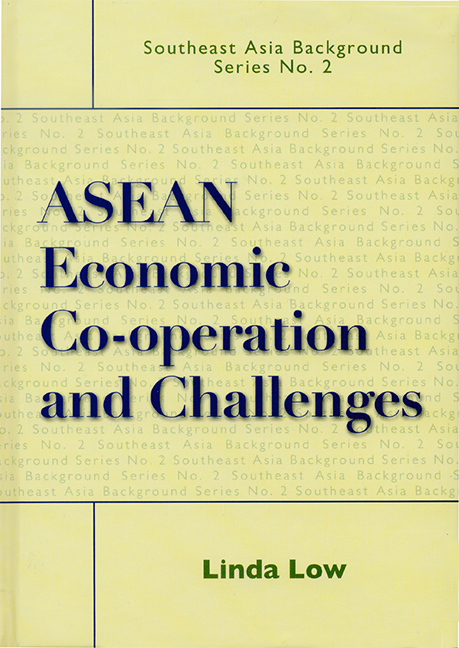4 - Other ASEAN Co-operation Efforts
Published online by Cambridge University Press: 21 October 2015
Summary
INTRODUCTION
In addition to trade and investment liberalization discussed in Chapters 2 and 3, this chapter looks at other ASEAN co-operation efforts.
The role of the private sector in trade, investment and other economic co-operation efforts is presented. As ASEAN takes an increasingly more market-oriented approach to economic co-operation, appreciating the role and importance of the private sector is imperative. The physical infrastructural networks are discussed, followed by e-ASEAN, social development and co-operation efforts, including an ASEAN community.
ASEAN PRIVATE SECTOR EFFORTS
While economic integration through government-to-government reduction of tariff and non-tariff barriers is at work, private sector participation is invaluable. The ASEAN Chambers of Commerce and Industry formed in 1972 takes part in ASEAN official meetings and projects. It has four tiers at the council governing and administration level, in regional commodity clubs, in national industry clubs and finally, in national commodity clubs. Again, these provide the platforms and occasions for ASEAN business and industry groups to get together for collaboration and shaping proposals for ASEAN leaders and officials. ASEAN Chambers of Commerce and Industry joint business and economic councils with dialogue partners provide the needed external extensions as well.
Reinforcing economic co-operation, certain areas and the private sector also contribute to greater socio-cultural interaction. These include energy, rural youth development and disease research and training, as shipping, banking, tours and travel, and fisheries.
More interestingly, growth triangles have evolved out of private sector efforts. Business relocation prompted by cost and other supply factors first prompted the migration of Singapore business into Johor in Malaysia in the late 1980s. This was extended to Batam in Riau, giving rise to the SIJORI configuration by 1989 before it was extended to more generic Indonesia- Malaysia-Singapore growth triangle. This in turn inspired the Indonesia-Malaysia-Thailand growth triangle and East ASEAN Growth Area covering Brunei-Indonesia-Malaysia-Philippines. The Greater Mekong Scheme has attracted Japanese interests since the late 1950s with the United Nations Development Plan's financial assistance in transport and communication involving Thailand, Vietnam, Cambodia and Yunnan province in China.
- Type
- Chapter
- Information
- ASEAN Economic Co-operation and Challenges , pp. 45 - 60Publisher: ISEAS–Yusof Ishak InstitutePrint publication year: 2004



